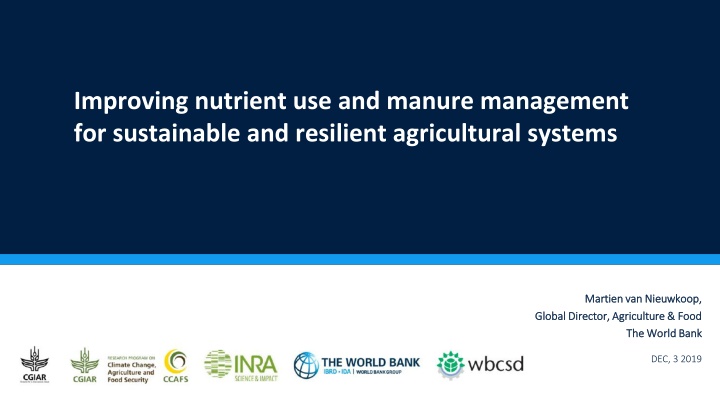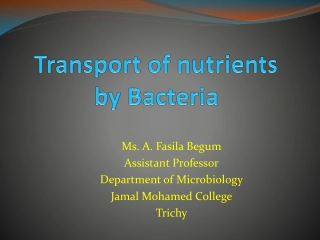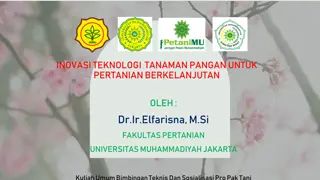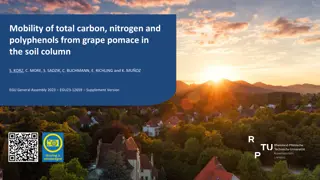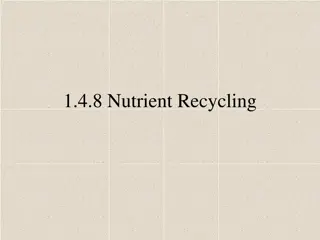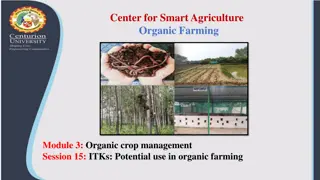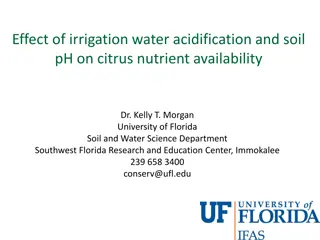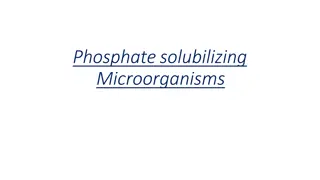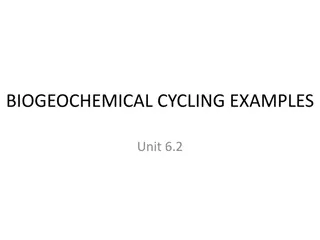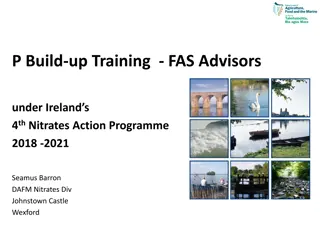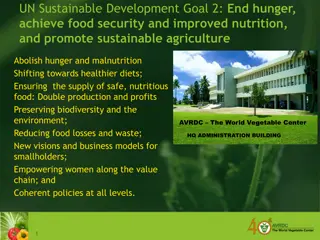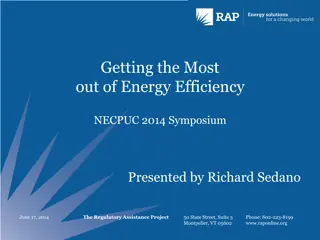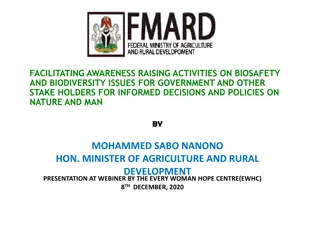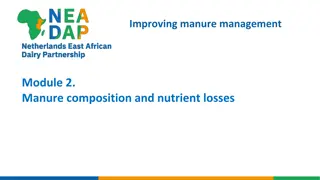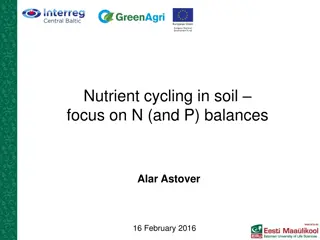Enhancing Nutrient Efficiency in Agriculture for Sustainable Systems
Improved nutrient use and manure management are crucial for sustainable agricultural systems. Efforts to increase nutrient efficiency through better practices can help reduce emissions and aquatic pollution. Public awareness, policy realignment, and soil data quality enhancements are key areas for promoting efficient nutrient management. Advancing these practices can significantly boost crop production, close yield gaps, and mitigate greenhouse gas emissions.
Download Presentation

Please find below an Image/Link to download the presentation.
The content on the website is provided AS IS for your information and personal use only. It may not be sold, licensed, or shared on other websites without obtaining consent from the author.If you encounter any issues during the download, it is possible that the publisher has removed the file from their server.
You are allowed to download the files provided on this website for personal or commercial use, subject to the condition that they are used lawfully. All files are the property of their respective owners.
The content on the website is provided AS IS for your information and personal use only. It may not be sold, licensed, or shared on other websites without obtaining consent from the author.
E N D
Presentation Transcript
Improving nutrient use and manure management for sustainable and resilient agricultural systems Martien van Nieuwkoop, Martien van Nieuwkoop, Global Director, Agriculture & Food Global Director, Agriculture & Food The World Bank The World Bank DEC, 3 2019
1 Global efficiency of added nutrients to soils through organic and synthetic fertilizers is only Global efficiency of added nutrients to soils through organic and synthetic fertilizers is only about 50% leading to 12% of total Emissions from Agriculture and aquatic pollution. about 50% leading to 12% of total Emissions from Agriculture and aquatic pollution. Better nutrient efficiency through better fertilizer application, manure management and Better nutrient efficiency through better fertilizer application, manure management and recycling of nutrients will contribute to making low recycling of nutrients will contribute to making low- -input more productive and high systems less emissions intense. systems less emissions intense. KEY input more productive and high- -input input MESSAGES . . Proven management practices that increase nutrient efficiency exist. However, more work is Proven management practices that increase nutrient efficiency exist. However, more work is needed to enable these practices to be implemented at scale. needed to enable these practices to be implemented at scale. Increasing public awareness & technical assistance; Realigning policies and financial Increasing public awareness & technical assistance; Realigning policies and financial mechanisms to incentivize nutrient and manure management planning; Improving soil data mechanisms to incentivize nutrient and manure management planning; Improving soil data quality & Monitoring, Reporting and Verification. quality & Monitoring, Reporting and Verification. KEY ACTION AREAS
Better nutrient management for raising yields and decreasing greenhouse gases needed Better nutrient management for raising yields and decreasing greenhouse gases needed Improving nutrient use efficiency Improving nutrient use efficiency may increase production by up to 70% for most may increase production by up to 70% for most crops crops and contribute significantly to closing global yield gaps. and contribute significantly to closing global yield gaps. ND Mueller et al. Nature 000, 1-4 (2012) doi:10.1038/nature11420
Improving nutrient use efficiency could mitigate 0.71 GtCO2e annually by 2030 Improving nutrient use efficiency could mitigate 0.71 GtCO2e annually by 2030 Griscom et. al 2017
Three priority action areas to advance the nutrient and manure management agenda Three priority action areas to advance the nutrient and manure management agenda To promote the nutrient and manure management agenda, To promote the nutrient and manure management agenda, we propose three priority action areas: we propose three priority action areas: o Priority #1: Priority #1: Making nutrient and manure management a priority in NDCs o Priority #2: Priority #2: Realigning public and private support for improving nutrient and manure management o Priority #3: Priority #3: Improving Monitoring, Reporting and Verification (MRV) for nutrient and manure management
Priority #1: Making nutrient and manure management a priority in NDCs Priority #1: Making nutrient and manure management a priority in NDCs Less than 25% of countries focused on mitigation commitments directly related to both fertilizer (43 countries) and manure management (46 countries) Technical assistance is needed to support countries to define and/or raise the ambition of nutrient management targets in their NDCs as well as to capture and disseminate the (co-)benefits of the improved nutrient use efficiency achieved Country updates to NDCs will be important entry points for providing technical support and awareness- raising KJWA could focus on: KJWA could focus on: Encouraging technical agencies to issue guidance for including nutrient management aspects into NDCs Promoting the prevention of soil degradation as a key intervention Enable NDC Partnership to provide nutrient management related support to help countries to implement their NDCs
Priority #2: Realigning public and private support for improving nutrient and manure management Priority #2: Realigning public and private support for improving nutrient and manure management More work is needed to identify global hot spots for nutrient management as well as to realign public and private More work is needed to identify global hot spots for nutrient management as well as to realign public and private support for delivering public support for delivering public- -good outcomes that promote nutrient use efficiency. Promising strategies include: good outcomes that promote nutrient use efficiency. Promising strategies include: Improving soil data quality and availability to farmers Tailoring regulations, incentives, and outreach to local conditions as there is no blueprint Improving extension and knowledge transfer systems KJWA could focus on: KJWA could focus on: Developing a policy brief under the Technology Executive Committee (TEC)13 on designing policy reforms to reduce distortions in public support programs related to nutrient management Drafting inputs to Green Climate Fund (GCF) strategy development to identify hot spots and leverage public and private investments toward improving nutrient management in hot spot areas
Priority #3: Improving Monitoring, Reporting and Verification (MRV) for nutrient and manure management Priority #3: Improving Monitoring, Reporting and Verification (MRV) for nutrient and manure management Assessments of fertilizer-derived emissions and the accuracy of mitigation protocols needs to be improved MRV related compliance cost needs to be lowered A standardized, accurate and low cost approach to MRV for assessing nutrient use efficiency in the context of productivity and emission trade-offs would provide a significant rationale for the use of public funds in support of improving nutrient and manure management KJWA could focus on: KJWA could focus on: Mobilizing requests from countries for support under the Climate Technology Centre and Network (CTCN)16 for Tools and methodologies for MRV on nutrient management Global guidelines for fertilizer use
Soil management and manure management often go hand in hand Soil management and manure management often go hand in hand Project Example: Uruguay : Uruguay - - Sustainable management of natural resources and climate change (DACC) Sustainable management of natural resources and climate change (DACC) Establishment of an Agricultural Information and Decision Support System On Farm CSA-Investments and Livestock Management Capacity Building and Training To support Uruguay's efforts to promote farmer adoption of climate-smart agricultural and livestock practices, and improved natural resource management practices in project areas Objective Objective & Means & Means Crop rotation and ground cover to minimize erosion and land degradation Regulated use of agrochemicals, including monitoring of applications, to reduce emissions from main agricultural systems Minimize and collect all effluent waste Soil and manure Soil and manure management management approaches approaches Soil Management Use Plans for sustainable land use practices Sustainable Intensification of Livestock Sector 2,509,000 hectares of land 2,509,000 hectares of land are under sustainable land management practices Impacts Impacts 36% increase in adaptive capacity, 36% increase in adaptive capacity, measured by a vulnerability matrix at department level including socio-economic, biophysical, and technical indicators DACC on DACC on- -farm investment in CSA has supported 5,139 farmers farm investment in CSA has supported 5,139 farmers to increase energy efficiency, soil management capacity and dairy production
Integrated soil nutrient management as part of integrated CSA projects Integrated soil nutrient management as part of integrated CSA projects Recently launched: China China - - Climate Smart Staple Crop Production Project Climate Smart Staple Crop Production Project Objective Objective To reduce GHG emissions in crop production, by improving efficiency of agricultural inputs (e.g. fertilizer, pesticides, irrigation water and agriculture machinery) and by promoting smart climate crop production systems Integrated of Integrated of package of CSA package of CSA technologies technologies resulting in resulting in strong soil strong soil benefits benefits Application of formula fertilizer and mechanized deep fertilization services to avoid over- fertilization & pilot of new techniques such as the use of new fertilizers (e.g., sulfur, slow release fertilizers, etc.) Precision pesticide application through procurement of high efficiency pest management equipment and professional pest management services Promotion of water conservation and efficient irrigation practices, e.g., laser land leveling and improvement of irrigation and drainage systems Conservation agriculture production techniques, e.g., crop residues returning to field, minimum tillage and no-tillage Piloting of alternative crop rotation production systems Promotion of agroforestry INTEGRATION
THANK YOU THANK YOU Martien van Nieuwkoop, Martien van Nieuwkoop, Global Director, Agriculture & Food Global Director, Agriculture & Food MvanNieuwkoop@worldbank.org MvanNieuwkoop@worldbank.org
11 Annex: Public Finance: Aligning Incentives for Adoption of Climate Smart Agriculture Options Annex: Public Finance: Aligning Incentives for Adoption of Climate Smart Agriculture Options Public Support to Agriculture by Category (2015-17) Total: US$ 570 billion per year Total: US$ 570 billion per year Equivalent to 28% of Agriculture Sector Value Added Equivalent to 28% of Agriculture Sector Value Added Market Market Price Price Support Support 52% 52% Two forms of public support have the most distortive Two forms of public support have the most distortive potential: potential: Production Production Payments Payments 22% 22% Coupled subsidies Coupled subsidies (i.e., tied to inputs or outputs): fertilizer subsidies, in particular, have contributed to the overuse of nitrogen fertilizer globally resulting in high GHG emissions and other environmental problems; Input Input Subsidies Subsidies 10% 10% Public Public Goods Goods 16% 16% Price support Price support, which encourages over-production of certain commodities and inefficient use of limited natural resources, and in some notable cases encourage land use conversion Environmental Environmental Purposes Purposes 1% 1%
Annex: Better nutrient management for raising yields and decreasing greenhouse gases needed Annex: Better nutrient management for raising yields and decreasing greenhouse gases needed ND Mueller et al. Nature 000, 1-4 (2012) doi:10.1038/nature11420
WHAT MAKES THE PROJECT STAND OUT WHAT MAKES THE PROJECT STAND OUT WHAT WHAT HOW HOW Taking a climate-smart agricultural approach, the country has quadrupled its agricultural production within a decade, while increasing the resilience and adaptation of their productive systems to climate change, and significantly reducing GHG emission associated with food production. The focus is agricultural production in a sustainable way. The project emphasizes increasing farmers productivity, while lowering emissions and impact on the natural environment. The project has supported the set-up and design of the National Agricultural Information System (SNIA). With a population of 3.7 million people, Uruguay currently produces food for 28 M people. The vision by 2050 is to produce food for 50 million people. SNIA facilitates the integration of dispersed agriculture, natural resource management and new climate-related information from 32 national agencies in an online state-of- the-art platform tailored to the needs of different users. Farmers access to internet allows the application of early- warning system for livestock management, an agrochemical control system, rural risk assessments, soil and land use plans, water studies for irrigation and precise climate forecasts. Driving innovation in climate-smart agricultural agenda To date it has seen over 70,000 uses and supported 9 important public-sector decisions.
